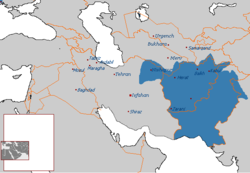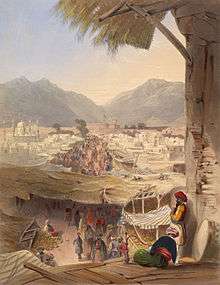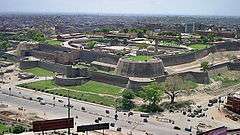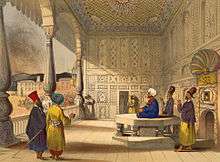Durrani Empire
The Durrani Empire (Pashto: د درانيانو ټولواکمني), also called the Sadozai Kingdom (د سدوزو واکمني)[8] and Afghan Empire (د افغانانو واکمني),[9] was founded and built by Ahmad Shah Durrani in parts of Central Asia, Middle East and South Asia. At its maximum extent, the empire ruled over what are now the modern-day countries of Afghanistan and Pakistan, as well as parts of northeastern and southeastern Iran, eastern Turkmenistan, and northwestern India.[10][11]
Durrani Empire د درانیانو ټولواکمني | |||||||||||||||||||
|---|---|---|---|---|---|---|---|---|---|---|---|---|---|---|---|---|---|---|---|
| 1747–1823, 1839–1842 | |||||||||||||||||||
 Flag | |||||||||||||||||||
 The Durrani Empire at its maximum extent under Ahmad Shah Durrani[2] | |||||||||||||||||||
| Capital | Kandahar (1747–1776) Kabul (1776–1823, 1839–1842) Peshawar (1776–1823; winter capital)[3][4] Herat (1823–1862)[5] | ||||||||||||||||||
| Common languages | Pashto (poetry, initially used in bureaucracy)[lower-alpha 1][6][7] Persian (chancery, chief court language)[7] | ||||||||||||||||||
| Religion | Islam | ||||||||||||||||||
| Government | Monarchy | ||||||||||||||||||
| Shah | |||||||||||||||||||
• 1747–1772 | Ahmad Shah Durrani (first) | ||||||||||||||||||
• 1839–1842 | Shuja Shah Durrani (last) | ||||||||||||||||||
| Historical era | Early modern period | ||||||||||||||||||
• Dynasty established by Ahmad Shah Durrani | July 1747 | ||||||||||||||||||
| 1839 | |||||||||||||||||||
• Disestablished | 1842 | ||||||||||||||||||
| |||||||||||||||||||
Ahmad Shah Abdali was the son of Muhammad Zaman khan Abdali(chief of the Abdali's).They were the heirs of Afghanistan through generations .After some disunity in the tribe in June 1747 Ahmad Shah Abdali was the king of Afghanistan.He secured Afghanistan.
After the death of Nader Shah Afshar in June 1747, the region of Kandahar was claimed by Ahmad Shah Durrani. From there, he conquered Ghazni, Kabul, and Peshawar in the same year. In 1749 the Mughal ruler had ceded sovereignty over much of northwest India to the Afghans. Ahmad Shah then set out westward to take possession of Mashhad, which was ruled by Shahrokh Shah. He next sent an army to subdue the areas north of the Hindu Kush and in short order all the different tribes began joining his cause. Ahmad Shah and his forces invaded India four times, taking control of Kashmir and the Punjab region. Early in 1757, he sacked Delhi, but permitted the Mughal dynasty to remain in nominal control as long as the ruler acknowledged Ahmad Shah's suzerainty over the Punjab, Sindh, and Kashmir.
After the death of Ahmad Shah in about 1772, his son Timur Shah became the next ruler of the Durrani dynasty who decided to make Kabul the new capital of the empire, and used Peshawar as the winter capital. The Durrani Empire is considered the foundation of the modern state of Afghanistan, with Ahmad Shah Durrani being credited as "Father of the Nation".[12]
Reign of Ahmad Shah Durrani (1747–1772)
Foundation of the Afghan state
In 1709 Mir Wais Hotak, chief of the Ghilji tribe of Kandahar Province, gained independence from the Safavid Persians. From 1722 to 1725, his son Mahmud Hotak briefly ruled large parts of Iran and declared himself as Shah of Persia. However, the Hotak dynasty came to a complete end in 1738 after being toppled and banished by the Afsharids who were led by Nader Shah Afshar of Persia.
The year 1747 marks the definitive appearance of an Afghan political entity independent of both the Persian and Mughal empires.[13] In July 1747 a loya jirga (grand council) concluded near the city of Kandahar with Ahmad Shah Durrani being selected as the new leader of the Afghans, thus the Durrani dynasty was founded. Despite being younger than the other contenders, Ahmad Shah had several overriding factors in his favor. He belonged to a respectable family of political background, especially since his father served as Governor of Herat who died in a battle defending the Afghans.
Early victories

One of Ahmad Shah's first military actions was to capture Qalati Ghilji and Ghazni from the Ghilji, and wrest Kabul and Peshawar from Mughal-appointed governor Nasir Khan. In 1749, the Mughal Emperor Ahmad Shah Bahadur was induced to cede Sindh, the Punjab region and the important trans Indus River to Ahmad Shah Durrani in order to save his capital from Afghan attack.[14] Having thus gained substantial territories to the east without a fight, Ahmad Shah turned westward to take possession of Mashhad, which was ruled by Nader Shah Afshar's grandson, Shahrukh Afshar. Ahmad Shah next sent an army to subdue the areas north of the Hindu Kush mountains. In short order, the powerful army brought under its control the Tajik, Hazara, Uzbek, Turkmen, and other tribes of northern Afghanistan. Ahmad Shah invaded the remnants of the Mughal Empire a third time, and then a fourth, consolidating control over the Kashmir and Punjab regions, with Lahore being governed by Afghans. He sacked Delhi in 1757 but permitted the Mughal dynasty to remain in nominal control of the city as long as the ruler acknowledged Ahmad Shah's suzerainty over Punjab, Sindh, and Kashmir. Leaving his second son Timur Shah to safeguard his interests, Ahmad Shah left India to return to Afghanistan.
Relations with China
Alarmed by the expansion of China's Qing Dynasty up to the eastern border of Kazakhstan, Ahmad Shah attempted to rally neighboring Muslim khanates and the Kazakhs to unite and attack China, ostensibly to liberate its western Muslim subjects.[15] Ahmad Shah halted trade with Qing China and dispatched troops to Kokand.[16] However, with his campaigns in India exhausting the state treasury, and with his troops stretched thin throughout Central Asia, Ahmad Shah lacked sufficient resources to do anything except to send envoys to Beijing for unsuccessful talks.
Third Battle of Panipat

The Mughal power in northern India had been declining after the death of Emperor Aurangzeb, who died in 1707. In 1751–52, Ahamdiya treaty was signed between the Marathas and Mughals, when Balaji Bajirao was the Peshwa.[18] Through this treaty, the Marathas controlled virtually the whole of India from their capital at Pune and the Mughal rule was restricted only to Delhi (the Mughals remained the nominal heads of Delhi). Marathas were now straining to expand their area of control towards the Northwest of India. Ahmad Shah sacked the Mughal capital and withdrew with the booty he coveted. To counter the Afghans, Peshwa Balaji Bajirao sent Raghunathrao. He defeated the Rohillas and Afghan garrisons in Punjab and succeeded in ousting Timur Shah and his court from India and brought Lahore, Multan, Kashmir and other subahs on the Indian side of Attock under Maratha rule.[19] Thus, upon his return to Kandahar in 1757, Ahmad was forced to return to India and face the formidable attacks of the Maratha Confederacy.
Ahmad Shah declared a jihad (or Islamic holy war) against the Marathas, and warriors from various Afghan tribes joined his army, including the Baloch people under the command of Khan of Kalat Mir Nasir I of Kalat. Suba Khan Tanoli (Zabardast Khan) was selected as army chief of all military forces. Early skirmishes were followed by victory for the Afghans against the much larger Maratha garrisons in Northwest India and by 1759 Ahmad Shah and his army had reached Lahore and were poised to confront the Marathas. Ahmad Shah Durrani was famous for winning wars much larger than his army. By 1760, the Maratha groups had coalesced into a big enough army under the command of Sadashivrao Bhau. Once again, Panipat was the scene of a confrontation between two warring contenders for control of northern India. The Third Battle of Panipat (14 January 1761), fought between largely Muslim and largely Hindu armies was waged along a twelve-kilometer front. Despite decisively defeating the Marathas, what might have been Ahmad Shah's peaceful control of his domains was disrupted by many challenges. As far as losses are concerned, Afghans too suffered heavily in the Third Battle of Panipat. This weakened his grasp over Punjab which fell to the rising Sikh misls. There were rebellions in the north in the region of Bukhara. The Durranis decisively defeated the Marathas in the Third Battle of Panipat on 14 January 1761.[20] The defeat at Panipat resulted in heavy losses for the Marathas, and was a huge setback for Peshwa Balaji Rao. He received the news of the defeat of Panipat on 24 January 1761 at Bhilsa, while leading a reinforcement force. Besides several important generals, he had lost his own son Vishwasrao in the Battle of Panipat. He died on 23 June 1761, and was succeeded by his younger son Madhav Rao I.[21]
Final years

The victory at Panipat was the high point of Ahmad Shah's—and Afghan—power. However, even prior to his death, the empire began to unravel. In 1762, Ahmad Shah crossed the passes from Afghanistan for the sixth time to subdue the Sikhs. From this time and on, the domination and control of the Empire began to loosen, and by the time of Durrani's death he had completely lost Punjab to the Sikhs, as well as earlier losses of northern territories to the Uzbeks, necessitating a compromise with them.[22]
He assaulted Lahore and, after taking their holy city of Amritsar, massacred thousands of Sikh inhabitants, destroying their revered Golden Temple.[23] Within two years, the Sikhs rebelled again and rebuilt their holy city of Amritsar. Ahmad Shah tried several more times to subjugate the Sikhs permanently, but failed. Durrani's forces instigated the Vaḍḍā Ghallūghārā when they killed thousands of Sikhs in the Punjab in 1762.[24][25][26] Ahmad Shah also faced other rebellions in the north, and eventually he and the Uzbek Emir of Bukhara agreed that the Amu Darya would mark the division of their lands.. Ahmad Shah retired to his home in the mountains east of Kandahar, where he died on April 14, 1773.[27] He had succeeded to a remarkable degree in balancing tribal alliances and hostilities, and in directing tribal energies away from rebellion. He earned recognition as Ahmad Shah Baba, or "Father" of Afghanistan.[4]
The Durrani Empire lost its control over Kashmir to the Sikh Empire in the Battle of Shopian in 1819.[28]
Other Durrani rulers (1772–1823)
Ahmad Shah's successors governed so ineptly during a period of profound unrest that within fifty years of his death, the Durrani empire per se was at an end, and Afghanistan was embroiled in civil war. Much of the territory conquered by Ahmad Shah fell to others in this half century. By 1818, the Sadozai rulers who succeeded Ahmad Shah controlled little more than Kabul and the surrounding territory within a 160-kilometer radius. They not only lost the outlying territories but also alienated other tribes and lineages among the Durrani Pashtuns.
Timur Shah (1772–1793)
Ahmad Shah was succeeded by his son, Timur Shah, who had been deputed to administer his father's conquests in Northern India, but had been driven out by the Marathas. Upon Ahmad Shah's death, the Durrani chieftains only reluctantly accepted Timur's accession. Most of his reign was spent fighting a civil war and resisting rebellion; Timur was even forced to move his capital from Kandahar to Kabul due to the insurgency. Timur Shah proved an ineffectual ruler, during whose reign the Durrani empire began to crumble. He is notable for having had 24 sons, several of whom became rulers of the Durrani territories. Timur died in 1793 and was then succeeded by his fifth son Zaman Shah
Zaman Shah (1793–1801)
| Part of a series on |
| Pashtuns |
|---|
| Kingdoms |

After the death of Timur Shah, three of his sons, the governors of Kandahar, Herat and Kabul, contended for the succession. Zaman Shah, governor of Kabul, held the field by virtue of being in control of the capital, and became shah at the age of twenty-three. Many of his half-brothers were imprisoned on their arrival in the capital for the purpose, ironically, of electing a new shah. The quarrels among Timur's descendants that threw Afghanistan into turmoil also provided the pretext for the interventions of outside forces.
The efforts of the Sadozai heirs of Timur to impose a true monarchy on the truculent Pashtun tribes, and their efforts to rule absolutely and without the advice of the other major Pashtun tribal leaders, were ultimately unsuccessful. The Sikhs started to rise under the command of Sikh chief, Ranjit Singh, who succeeded in wresting power from Zaman's forces. Later when Zaman was blinded by his brother, Ranjit Singh who gave him asylum in Punjab.
Zaman's downfall was triggered by his attempts to consolidate power. Although it had been through the support of the Barakzai chief, Painda Khan Barakzai, that he had come to the throne, Zaman soon began to remove prominent Barakzai leaders from positions of power and replace them with men of his own lineage, the Sadozai. This upset the delicate balance of Durrani tribal politics that Ahmad Shah had established and may have prompted Painda Khan and other Durrani chiefs to plot against the shah. Painda Khan and the chiefs of the Nurzai and the Alizai Durrani clans were executed, as was the chief of the Qizilbash clan. Painda Khan's son fled to Iran and pledged the substantial support of his Barakzai followers to a rival claimant to the throne, Zaman's younger brother, Mahmud Shah. The clans of the chiefs Zaman had executed joined forces with the rebels, and they took Kandahar without bloodshed.
Mahmud Shah (first reign, 1801–1803)
Zeman Shah's overthrow in 1801 was not the end of civil strife in Afghanistan, but the beginning of even greater violence. Mahmud Shah's first reign lasted for only two years before he was replaced by Shuja Shah.
Shuja Shah (1803–1809 and 1839–1842)
Yet another of Timur Shah's sons, Shuja Shah (or Shah Shuja), ruled for only six years. On June 7, 1809, Shuja Shah signed a treaty with the British, which included a clause stating that he would oppose the passage of foreign troops through his territories. This agreement, the first Afghan pact with a European power, stipulated joint action in case of Franco-Persian aggression against Afghan or British dominions. Only a few weeks after signing the agreement, Shuja was deposed by his predecessor, Mahmud. Much later, he was reinstated by the British, ruling during 1839–1842. Two of his sons also ruled for a brief period in 1842.
Mahmud Shah (second reign, 1809–1818)
Mahmud's second reign lasted nine years. Mahmud alienated the Barakzai, especially Fateh Khan, the son of Painda Khan, who was eventually seized and blinded. Revenge would later be sought and obtained by Fateh Khan's youngest brother, Dost Mohammad Khan.
Sultan Ali Shah (1818–1819)
Ali Shah was another son of Timur Shah. He seized power for a brief period in 1818–1819.
Ayub Shah (1819–1823)
Ayub Shah was another son of Timur Shah, who deposed Sultan Ali Shah. The Durrani Empire lost its control over Kashmir to the Sikh Empire in the Battle of Shopian in 1819.[28] Ayub Shah was himself later deposed, and presumably killed in 1823.
See also
- Indian Campaign of Ahmad Shah Durrani
- List of Pashtun empires and dynasties
- Deoni
Notes
- Ahmad Shah Durrani wrote poetry in Pashto.[6]
References
- http://www.iranicaonline.org/articles/afghanistan-x-political-history#prettyPhoto[sidebar]/1/
- http://www.iranicaonline.org/articles/afghanistan-x-political-history#prettyPhoto[sidebar]/1/
- Hanifi, Shah Mahmoud. "Timur Shah transferred the Durrani capital from Qandahar in 1775-76. Kabul and Peshawar then shared time as the dual Durrani capital cities, the former during the summer and the latter during the winter season." p. 185. Connecting Histories in Afghanistan: Market Relations and State Formation on a Colonial Frontier. Stanford University Press, 2011. Retrieved 2012-08-04.
- Singh, Sarina (2008). "Like the Kushans, the Afghan kings favoured Peshawar as a winter residence, and were aggrieved when the upstart Sikh kingdom snatched it in 1818 and levelled its buildings." p. 191. Pakistan and the Karakoram Highway. Retrieved 2012-08-10.
- L. Lee, Jonathan (1996). The Ancient Supremacy: Bukhara, Afghanistan and the Battle for Balkh, 1731-1901 (illustrated ed.). BRILL. p. 116. ISBN 9004103996. Retrieved March 8, 2013.
[The Sadozai kingdom] continued to exist in Herat until the city finally fell to Dost Muhammad Khan in 1862.
- Schimmel 1975, p. 12.
- Green, Nile (2019). "The Rise of New Imperial and National Languages (Ca. 1800-Ca. 1930)". In Green, Nile (ed.). The Persianate World: The Frontiers of a Eurasian Lingua Franca. University of California Press. p. 42. ISBN 978-0520972100.
Despite Ahmad Shah Durrani's flirtations with founding a Pashto-based bureaucracy, when the capital moved from Qandahar to Kabul in 1772, Durrani and post-Durrani Afghanistan retained Persian as its chancery and chief court language.
- Lee, Jonathan L. (1996-01-01). The "Ancient Supremacy": Bukhara, Afghanistan and the Battle for Balkh, 1731-1901. BRILL. p. 116. ISBN 9789004103993.
- "Last Afghan empire". Louis Dupree, Nancy Hatch Dupree and others. Encyclopædia Britannica. 2010. Retrieved 2010-08-25.
- "Archived copy" (PDF). Archived from the original (PDF) on 2013-02-07. Retrieved 2013-02-07.CS1 maint: archived copy as title (link)
- Jonathan Lee, The "ancient Supremacy": Bukhara, Afghanistan, and the Battle for Balkh, 1731-1901. Page 190.
- "Afghanistan". CIA. The World Factbook. Retrieved 2010-08-25.
- D. Balland (December 15, 1983). "Afghanistan x. Political History". Encyclopædia Iranica. Retrieved 2012-08-08.
- Meredith L. Runion The History of Afghanistan pp 69 Greenwood Publishing Group, 2007 ISBN 0313337985
- Kim, Ho-dong (2004). Holy war in China: the Muslim rebellion and state in Chinese Central Asia, 1864-1877. Stanford University Press. p. 20. ISBN 978-0-8047-4884-1. Retrieved 2010-08-25.
- Newby, Laura J. (2005). The Empire and the Khanate: a political history of Qing relations with Khoqand c. 1760-1860. BRILL. p. 34. ISBN 978-90-04-14550-4. Retrieved 2010-08-25.
- S. M. Ikram (1964). "XIX. A Century of Political Decline: 1707–1803". In Ainslie T. Embree. Muslim Civilization in India. New York: Columbia University Press. Retrieved 5 November 2011.
- Patil, Vishwas. Panipat.
- Roy, Kaushik. India's Historic Battles: From Alexander the Great to Kargil. Permanent Black, India. pp. 80–1. ISBN 978-81-7824-109-8.
- Kaushik Roy (2004). India's Historic Battles: From Alexander the Great to Kargil. Orient Blackswan. pp. 84–94.
- G.S.Chhabra (1 January 2005). Advance Study in the History of Modern India (Volume-1: 1707-1803). Lotus Press. pp. 29–47. ISBN 978-81-89093-06-8.
- Meredith L. Runion The History of Afghanistan pp 71 Greenwood Publishing Group, 2007 ISBN 0313337985
- Purnima Dhavan, When Sparrows Became Hawks: The Making of the Sikh Warrior Tradition, 1699, (Oxford University Press, 2011), 112.
- ^ Khushwant Singh, A History of the Sikhs, Volume I: 1469-1839, Delhi, Oxford University Press, 1978, pp. 144-45.
- ^ According to the Punjabi-English Dictionary, eds. S.S. Joshi, Mukhtiar Singh Gill, (Patiala, India: Punjabi University Publication Bureau, 1994) the definitions of "Ghalughara" are as follows: "holcaust, massacre, great destruction, deluge, genocide, slaughter, (historically) the great loss of life suffered by Sikhs at the hands of their rulers, particularly on 1 May 1746 and 5 February 1762" (p. 293).
- Syad Muhammad Latif, The History of Punjab from the Remotest Antiquity to the Present Time, New Delhi, Eurasia Publishing House (Pvt.) Ltd., 1964, p. 283; Khushwant Singh, A History of the Sikhs, Volume I: 1469-1839, Delhi, Oxford University Press, 1978, p. 154.
- Reddy, L. R (2002). Inside Afghanistan: end of the Taliban era?. APH Publishing. p. 65. ISBN 978-81-7648-319-3. Retrieved 2010-08-25.
- Chopra, Gulshan Lall (1928). The Panjab as a Sovereign State. Lahore: Uttar Chand Kapur and Sons. p. 26.
Sources
- Malleson, George Bruce (1879) History of Afghanistan, from the Earliest Period to the Outbreak of the War of 1878 W.H. Allen & Co., London, OCLC 4219393, limited view at Google Books
- Schimmel, AnneMarie (1975). Pain and Grace: A study of Two Mystical Writers of Eighteenth-Century Muslim India. Brill.CS1 maint: ref=harv (link)
- Singh, Ganda (1959) Ahmad Shah Durrani: Father of Modern Afghanistan Asia Publishing House, London, OCLC 4341271
- Fraser-Tytler, William Kerr (1953) Afghanistan: A Study of Political Developments in Central and Southern Asia Oxford University Press, London, OCLC 409453
- Tanner, Stephen (2002) Afghanistan : a military history from Alexander the Great to the fall of the Taliban Da Capo Press, New York, ISBN 0-306-81164-2, also available from NetLibrary
- Elphinstone, Mountstuart 1779-1859 An account of the kingdom of Caubul, and its dependencies in Persia, Tartary and India : comprising a view of the Afghaun nation and a history of the Dooraunee monarchy.London : Printed for Longman, Hurst, Rees, Orme, and Brown, 1815. Available in digital formats from the Internet Archive Digital Library
External links
| Wikimedia Commons has media related to Durrani Empire. |
- Afghanistan 1747–1809: Sources in the India Office Records
- Some details and images of Durrani coins
- Biography of Ahmad Shah Abdali (Durrani)
- Ahmad Shah Baba
- History of Abdali tribe
- Afghanistan and the Search for Unity Article on Durrani methods of government, published in Asian Affairs, Volume 38, Issue 2, 2007, pp. 145–157.
- Afghanistan & the British Raj From the Royal Geographical Society of South Australia blog entry with information on the Durrani Empire of Ahmad Shah, "Pearl of the Pearls". From an extensive collection of 19th century British reference works on travel and exploration in Afghanistan.
